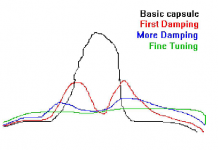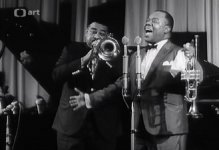No way to use a condenser mike for singer's voice on stage: Too sensible to "Pops", humidity, larsen, too fragile and...
Excepting maybe Neumann KMS 105 handheld condenser?
PMA, the ECM8000 is a TOY! It is a pretend measurement microphone, it only specifies frequency linearity, not distortion. It retails in the USA at $60, a heck of a bargain, IF you do not take it too seriously.
Why not examine PMA's measurements before you criticize?
A lot of studio people can tell what model microphone was used on a recording just by listening. Microphone selection for pop music recording is part of shaping the sound, and not necessarily for lack of distortion. A two-mic stereo technique for recording an orchestra might be different.
Is that really true outside of the stupidly expensive musical instruments such as the U47 which have a sonic signature bordering on 'broken'? Can someone listen to a finished mix and say 'ah xyz on kick, abc on cymbals etc for modern high quality units vs ancient tone controls?
Brilliant, Howie. May-be not the case, but brilliant.Perhaps this was directly picked up by the microphone coil? Not all microphone designs use humbucking coil setups, and I am not sure even when they do they would be effective at 15 KHz.
Those measurements leave me speechless. I dont believe that such intermodulation could have gone unnoticed, especially with 12-string guitars.
Even at very low level, every parasitic frequency under the fondamental is something of very audible, I think. May-be i'm wrong ?
It's very confusing, It's worth digging deeper.
You can't say this.Is that really true outside of the stupidly expensive musical instruments such as the U47 which have a sonic signature bordering on 'broken'?
We know all the bumps in the high medium, and the effect of proximity in the low medium (in cardioid), but they are of a ... surgical precision . Microscopes. Unequaled for human voices till now, on my taste.
I owned, during all my professional life, a very old one, tube powered, internal grill removed, found by me in a English studio as exceptional, that I bought at the price of gold. Everybody used to say "Wow" when I used-it in studios.
I would not have sold it for all the gold in the world.
I gave it to a talented young sound engineer whom I love as my son. But, you are right: A musical instrument. A stradivarius .
He will not sell-it for all the gold of the world.
Last edited:
Is that really true outside of the stupidly expensive musical instruments such as the U47 which have a sonic signature bordering on 'broken'? Can someone listen to a finished mix and say 'ah xyz on kick, abc on cymbals etc for modern high quality units vs ancient tone controls?
Wow - a lot of really great recordings were made with broken mics.
WRT identifying mics from a recording, in reality it's not very easy, given the
plethora of mic pre's used, all of which have their own signature. Many
peoples analog IP chain (to digital) will also include a compressor.
So at the end of the day, the IP chain might go through quite a few
transformers, valves, some kind of gain reduction element (VCA / FET /
Opto) and maybe even some EQ.
T
No way to use a condenser mike for singer's voice on stage: Too sensible to "Pops", humidity, larsen, too fragile and... expensive ;-)
Here, try one of these:
RODE Microphones - S1
I don't see them very often but I'm also sure not many engineers know of
them.
T
A lot of great music is poorly recorded*. A lot of well recorded music is rubbish  . I have no issue with a 50 year old microphone being used as a tone control, I just feel it should be accepted that its rubbish, but in a good way
. I have no issue with a 50 year old microphone being used as a tone control, I just feel it should be accepted that its rubbish, but in a good way  .
.
*If the music is good I don't care about the quality. I'd take Rachmaninoff playing his own works off acoustic 78s over the latest greatest issues.
*If the music is good I don't care about the quality. I'd take Rachmaninoff playing his own works off acoustic 78s over the latest greatest issues.
A lot of great music is poorly recorded*. A lot of well recorded music is rubbish. I have no issue with a 50 year old microphone being used as a tone control, I just feel it should be accepted that its rubbish, but in a good way
.
*If the music is good I don't care about the quality. I'd take Rachmaninoff playing his own works off acoustic 78s over the latest greatest issues.
Sinatra is rubbish - in a good way?
T
Brilliant, Howie. May-be not the case, but brilliant.
.
Just baffle the acoustic input at the same position with something non-magnetic. I think you will be surprised, all precision acoustic instrumentation applications use condenser mics some are <1% at 150dB SPL. There are lots of potential distortion mechanisms in dynamic microphones that are not in condenser mics.
I have some early mono sinatra. The recording quality is frankly pants. Noisy, distorted band etc. But the music is great. That was my point. And I know sinatra is not universally loved...
Of course they are, many of the recordings have been hammered.
But many of his recordings are really good. Same mic.
Most importantly, that mic suits his voice beautifully.
That's what engineers are looking for, not some kind of distortion
measurement.
T
Excepting maybe Neumann KMS 105 handheld condenser?
Or Bruel & Kjaer... Ask John Curl
Most of the ECM8000's distortion at higher SPL is coming from the capsule's JFET wired as gain stage, not as a buffer. Once rewired to buffer (see Linkwitz mod) it fares much better (but not great as freq response isn't well defined/controlled)PMA, the ECM8000 is a TOY! It is a pretend measurement microphone, it only specifies frequency linearity, not distortion. It retails in the USA at $60, a heck of a bargain, IF you do not take it too seriously.
Hi John,
Then why on earth don't you just weigh in with correct information as you see it?
-Chris
I would suggest someone (George
Dynamic Mics
By far, the most popular mic on the market today is the dynamic cardioid mic, so that's as good a place as any to start. "How does it work, what exactly is a cardioid, and how and where would you use it" will be our focus today. Let's look inside one and see what we find:
Well, it has a cone (like a small speaker), a voice coil (like a small speaker), and it sits in a magnetic gap (like a small speaker), so isn't it just a small speaker in reverse? Yes, and no. The operating principle is the same, but the execution is very different. When's the last time you saw a 3/4" speaker that went down to 30 or 40 Hz? Here's how it's done:
The system resonance is chosen for a mid band frequency. By itself, the capsule's response looks something like this: (the black line)
just one big resonant peak, with the response falling off rapidly on each side of the peak. Now you can tame that peak by putting in a resonant chamber that's tuned to that peak, which will give you two smaller peaks on either side, like red line:
And if you add two more resonant chambers, tuned for each or those peaks, you wind up looking more like the blue line and finaly the green line:
but remember, it's still a lot like a bunch of tuned coca cola bottles inside there. Now ya gotta do all of this stuff JUST to get the response usable - never mind about the mic pattern yet!
A lot more to come!! Everybody still with me at this point? Any questions?
Attachments
Last edited:
I had one on test for a gig, 10 years ago or such. Used-it for one of the female chorister to try. (I Did not want to take any risk with the leader singer.) Found-it warm and light sounding. Good larsen rejection. Indeed.Here, try one of these:
RODE Microphones - S1
Only defect, If I remember well, a little prone to be too sensible to the drum's cymbals if too close.
It was near the end of my professional activity, so ...
To advise, yes, I believe. Thanks.
it fares much better (but not great as freq response isn't well defined/controlled)
It changes, but I see no reason for it being less controlled. It would need recalibration not easily done by the user. For low frequency distortion measurement I see no material changes.
Really? See picture belowNo way to use a condenser mike for singer's voice on stage: Too sensible to "Pops", humidity, larsen, too fragile and... expensive ;-)
Attachments
Last edited:
- Status
- Not open for further replies.
- Home
- Member Areas
- The Lounge
- John Curl's Blowtorch preamplifier part III

